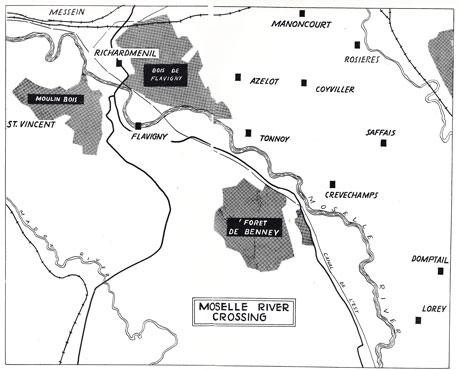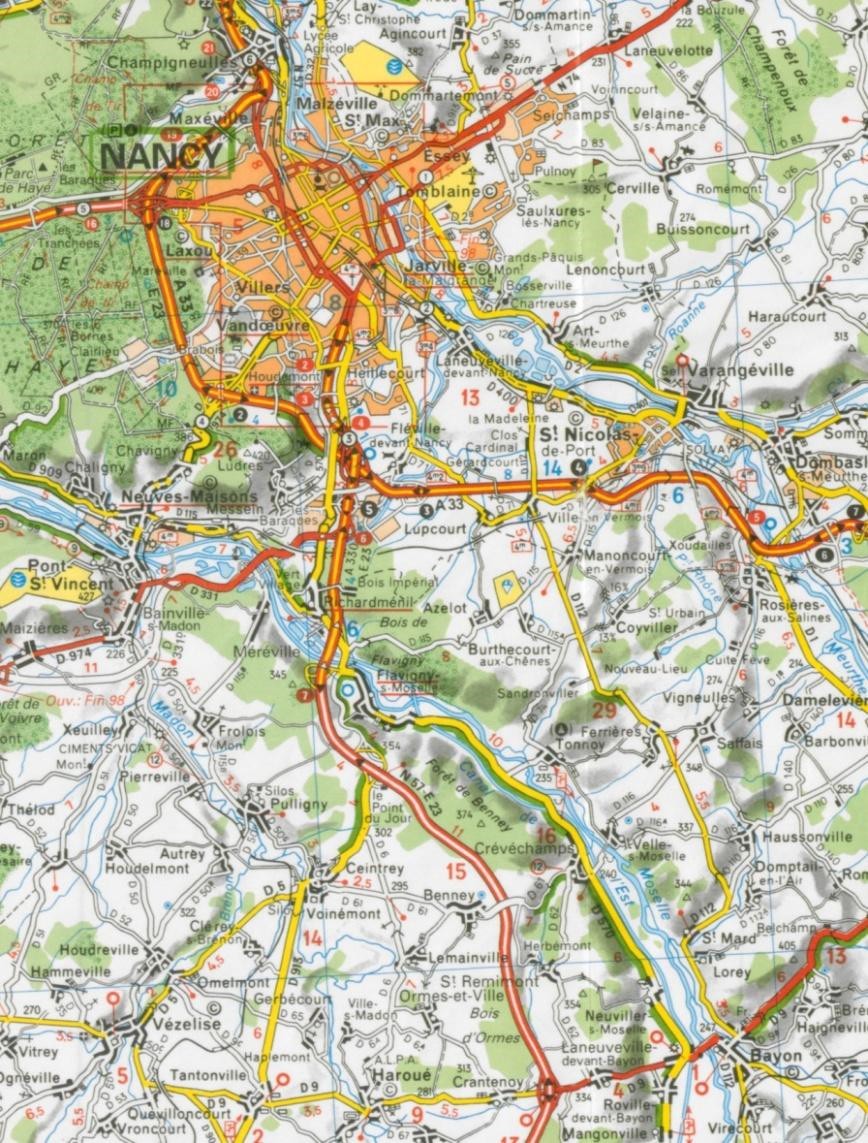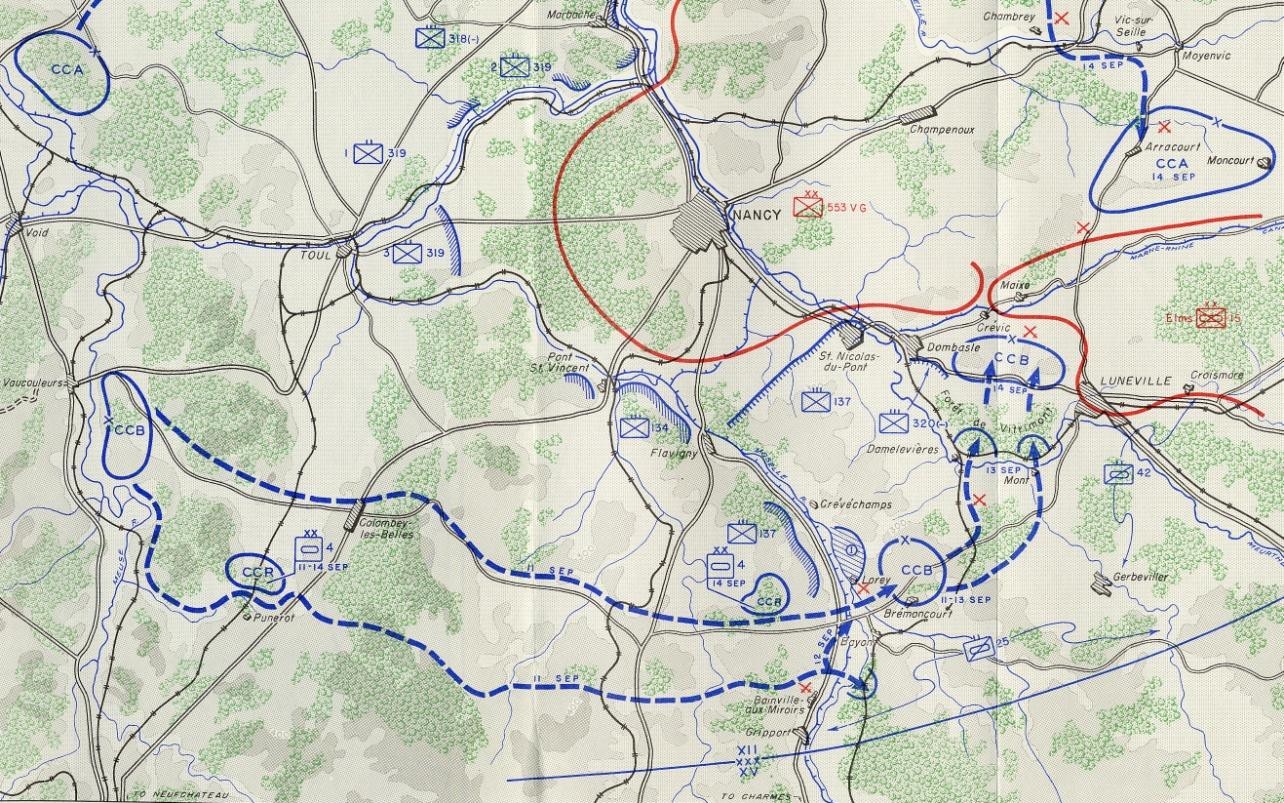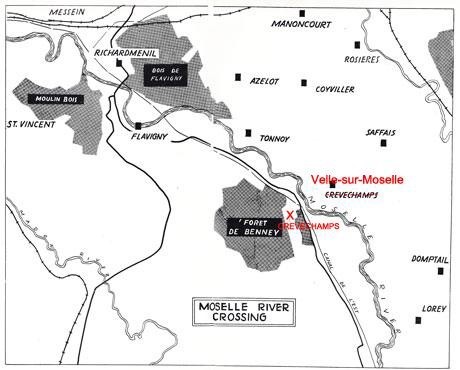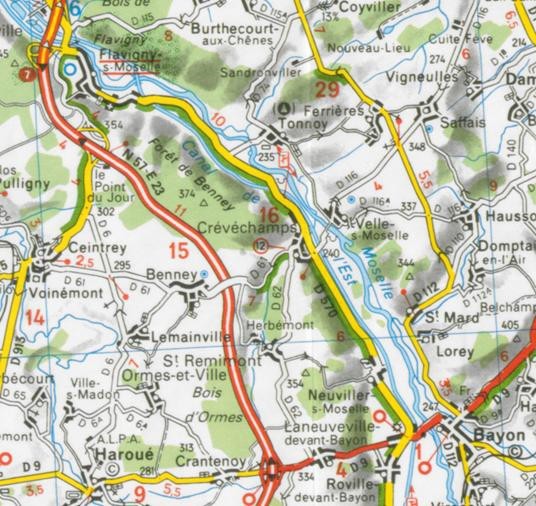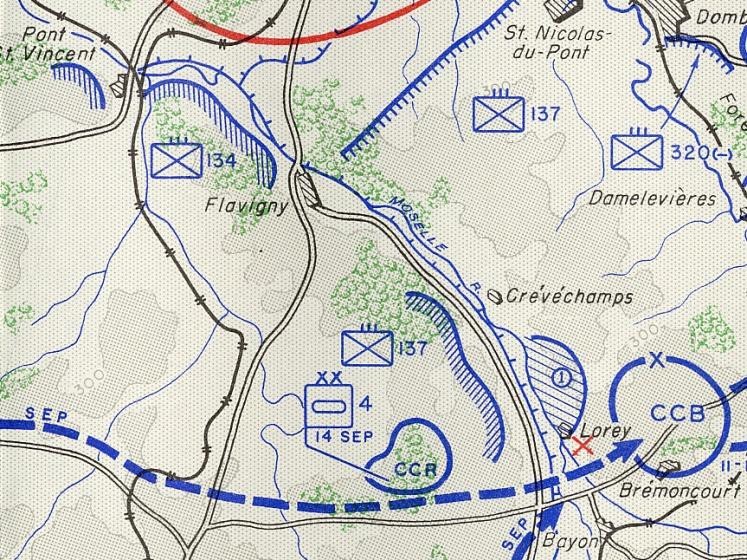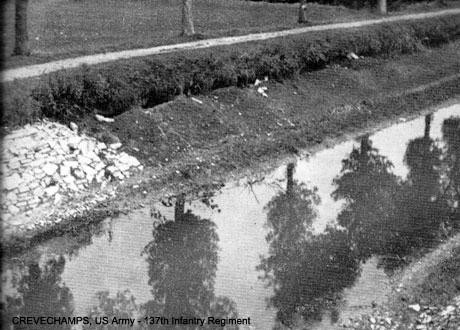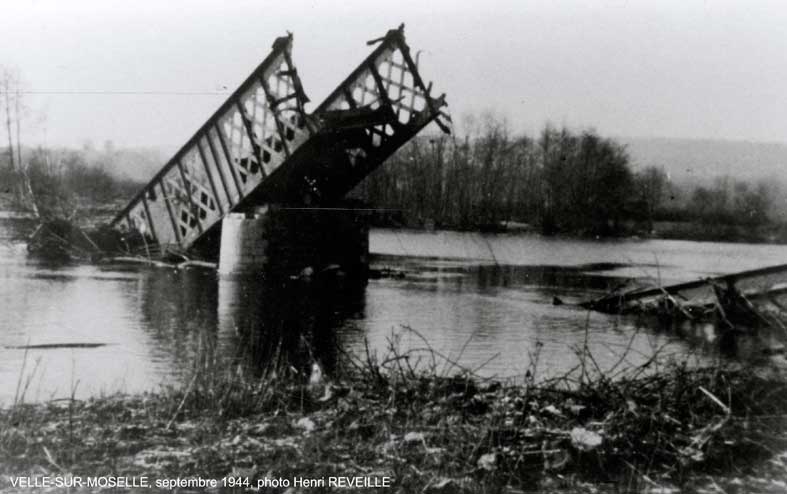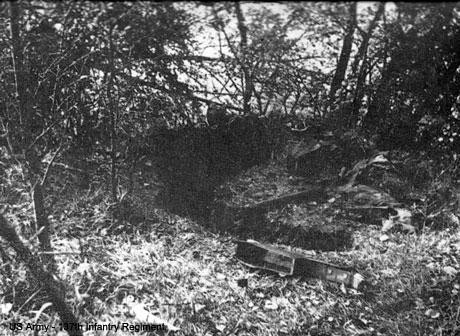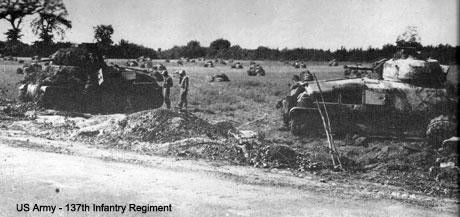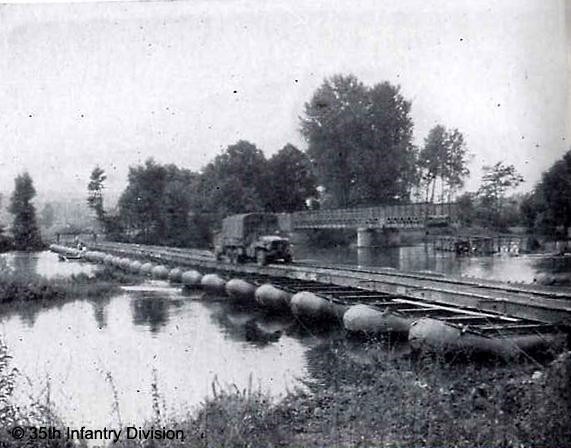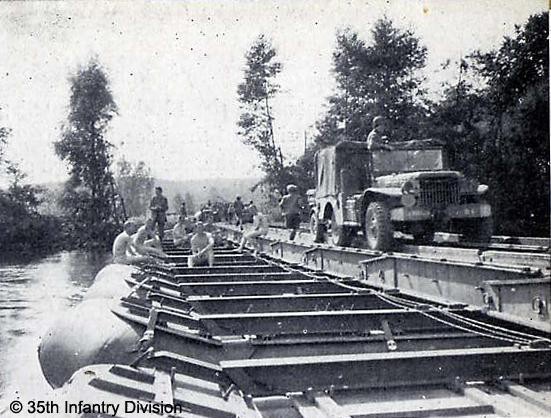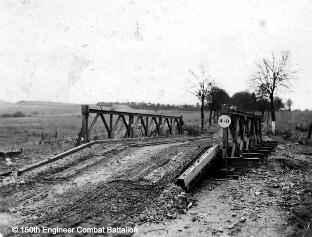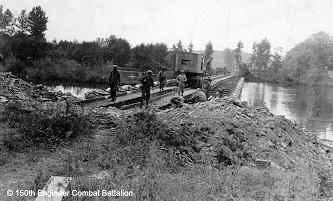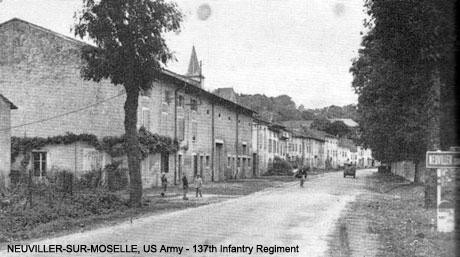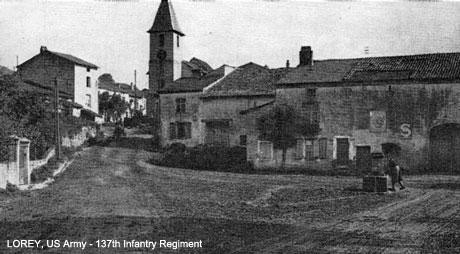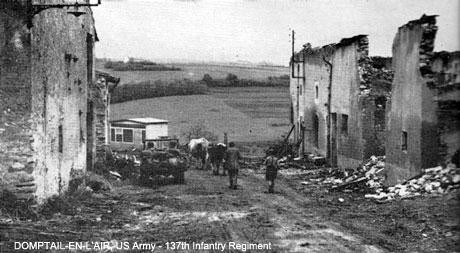Note: the tanks are French tanks "Somua S-35"
captured in 1940, and used by the Germans
The S-35 was designed in response to a request made
by the French armored cavalry for a new medium tank. SOMUA's prototype
was chosen in 1935, and it entered service in 1936. At the time of
Germany's invasion, the S-35 was considered the best tank in France's
arsenal, and around 250 were available for frontline service. However,
the tank's effectiveness was reduced since it was usually used in small
numbers to support infantry, which lead to them being overwhelmed by the
German's numbers. After France was defeated, some S-35s went into
German service as the PzKpfw 35-S 739(f). (source:
http://world-war-2.wikia.com/wiki/SOMUA_S-35)
Transcribed
by Roberta
V.
Russo, Palatine
IL
DEDICATION
We
never
knew
how
just
was our
cause
until
we entered the
rotten
interior of Germany
and
beheld
for
the
first time
the unbelievable
results
of Nazi greed
and
cruelty - the
shallow,
quick lime
graves -
the
feeble thanks and tears
of
joy
of
the emaciated
walking dead - the
slave
laborers, who
were former
free
men in
Europe - miserable
wretches whose
plight might well
have
been the
lot
of our own loved
ones had
we not
succeeded.
May this
history,
then,
be
dedicated to those
who
died
inconspicuously, but not in
vain, that freedom might
live.
PREFACE
This
history has been prepared through
the
joint collaboration
of the
following
officers
and
enlisted
men:
Captain
Jack
L. Smith -
Representative of
Regimental
Headquarters and
Special
Units.
Major Robert
L.
Stephenson - Representative of
First Battalion
Lt.
Col.
George
T.
O'Connell - Representative of
Second
Battalion
Lt.
Col.
Albert M. Butler - Representative
of Third Battalion
M/Sgt. Chester
V. Jackson - Regimental Operations Sergeant.
All
officers
and non-commissioned
officers
listed
above were
with
the
Regiment
during
the
entire action and
have
religiously
edited
and
compiled
all
available
sources
of
material
to
insure a
correct
and
accurate
history of
the
action
of
the
137th
Infantry
during
World
War II.
We
would
also
like to express
our
appreciation
to 1st
Lt. William Beasley for
the
work
he
did in checking
and
correcting
the
proofs for
this
book.
Much
credit
is due
the
members of the
Regimental and
Battalion
Operations sections
who are
no
longer
with
the
Regiment for
the
vast
amount
of
fragmentary information
recorded
during
the
heat of battle, which has
helped
immeasurably
in
the
compilation
of this
history.
NORTHERN
FRANCE
Chapter
Three
. . .
On
September 10
the
XII
Corps was
to advance into a
position to attack
on the next
day, with the
high
ground
west
of
the
Moselle
River
southeast
of
Nancy
as
the
objective.
The
134th
Infantry
was
to
attack
to
the
north,
and in the
137th
Infantry
the
3rd
Battalion
was
to
attack
on the right and the
2nd
Battalion
on the
left.
The
1st
Battalion
was
to
remain
in
reserve,
prepared
to
move
on
order.
The
Regiment
moved
out
at
0800
on
the
10th,
and
the
2nd
Battalion
encountered
the
first
enemy
fire - intermittent
artillery
at
0915 east
of
Houdelmont. They
continued
to
move
forward,
and
by
1300
crossed
the
north-south
highway
between
Ceintrey
and
the
Benney
Forest.
A
half-hour
later
the
2nd
Battalion
was in
the
Benney
Forest
itself,
and
two
miles
south
the
3rd
Battalion
had
reached
Lemainville.
At
that
time
the
1st
Battalion
was
at
Ville
sur
Moselle
(Madon) and
by
1500
had
moved
into
the
woods
south
of
Ormes
et
Ville.
By 1700,
137th
was
in
its
objective
for
the
10th
and
occupied
the
high
ground
west
of
the
Moselle
River,
in
position
to
attempt
to
establish
a
bridgehead
on
the
following
morning.
The
only casualties
reported
on
the
10th
were
two
men
wounded.
With
the
German
forces
withdrawn
to
positions
across
the
Moselle,
only
one
prisoner
was
taken.
The
Regiment
jumped
off
at
0500
on
September
11,
with the
2nd
Battalion
attempting
to
cross
the
river
near Crevechamps
and
the
3rd
Battalion
near Neuviller
sur
Moselle.
The 1st
Battalion
remained
in
reserve
in
the
Ormes
Forest.
First across
the
Moselle
at
that
point
was
1st
Lieutenant
Joseph S.
Giacobello, holder
of
the Silver
Star
and
already
recommended for
the
Oak
Leaf
Cluster
for
heroic
action
in
previous
engagements. With
fifteen
men
of
Company
F
he
crossed
the
river,
and
was
soon
out
of
communication
with
the
rest
of
the
battalion.
The
remainder of
Company
F
was
pinned
down
most
of
the
day
on
an
island
in
the
river
below
Crevechamps (Velle-sur-Moselle).
The
crossing
proved
difficult,
as
the
Germans
had
blown
all
bridges
across
the Moselle from
Flavigny
south,
and
they
held
strong
positions
on
the
east
side
of
the
river,
with
machine
gun
emplacements
on
the
steep
bluffs
overlooking the
river,
and
artillery
positions
to
the rear.
The
canal
running
parallel
to
the
river's
west bank
was
an
added
barrier.
The 2nd
Battalion
was never
able
to
put
additional
forces across
the
river
in
the
Crevechamps (Velle-sur-Moselle)
vicinity
during
the
day.
Lieutenant Giacobello
and
his
men
were
the
only
American
troops
across the
river at that point
for
a
day and a half,
and
were
believed to have
been lost, in the
face
of
almost
hopeless
odds.
The
Battalion
eventually abandoned
a
crossing
at
that
point
and
withdrew
to
attempt
a
crossing
farther
south.
Elements
of
the 3rd
Battalion
crossed
the
river
in
its
sector during the
day, but
were
pinned
down
until
late
in the
afternoon.
At
1730
the
1st
Battalion was
committed, and a
coordinated
attack
launched
by all
three
battalions, with
the
2nd
on
the
left,
the
1st
on
the
right,
and
the 3rd
between
them.
With
heavy
artillery
support,
the
1st
and
3rd
Battalions each
got
two
companies
across
the
river
by
1845
in
the
vicinity
of
Lorey and
St.
Mard.
The
strong
enemy
resistance
of
Crevechamps (Velle-sur-Moselle)
forced abandonment
of
the
construction
of
a
treadway
bridge
across
the
river
at
that
point.
The
attack
continued
during the
night,
and
by
the
morning
of
September
12,
the
1st
Battalion
had
cleared
all
enemy
resistance in
the
area
around
Lorey.
The
2nd
Battalion, to
the
north,
got
across
the
river
early
in
the
afternoon,
the
worked
back
up
the
east
side
of
the
river
and
was
rejoined
by
Lieutenant
Giacobello
with
his
party
intact.
In
the
3rd
Battalion
sector,
dug-in
concrete
pillboxes
were
located.
Four
of
these
were
knocked out
by
means
of
artillery,
bazookas,
and
grenades.
The 2nd
Battalion
also reported
concrete
pillboxes
near
Crevechamps (Velle-sur-Moselle).
At
0915,
the
3rd
Battalion
captured
a
former
enemy
command
post
and a
large
quantity
of
German equipment
left behind
in
the
area. The
equipment
was of
excellent
quality,
indicating
superior
troops
in
the
area.
With
the
way
cleared
by
the
1st
Battalion, it
was
possible
to
put a
ferry
into
operation
across the
river
at Neuviller,
and
shortly
afterward
a
treadway
bridge
was
completed
at
that
point
by
the
Engineers.
By
the
afternoon
most
of
the
Regiment
was
across
the
river.
The
1st
Battalion
moved
as
far
as
Lorey,
where
the
Germans
launched
a
counterattack
with
armor
and infantry
in
a
desperate
effort
to
save ammunition
stores
in
that
vicinity. With
the
support
of
Company
B
of
the
737th
Tank
Battalion, Company
C
broke
up the
counterattack,
then
moved
in
to
destroy
an
ammunition
dump at
Domptall.
Racing
to
the
left,
they
cleaned
out
the
hills
east
of the
river,
then
swung
in
between
the
2nd
and
3rd
Battalions. By
2100
the
2nd
Battalion took
Crevechamps (Velle-sur-Moselle), after
a
large
part
of
the
town had
been
set
afire,
and
the
Regiment
was
in
a
position
to
turn
the
attack
to
the
north.
On
September 13 the
137th
Infantry
attacked
toward
Gayviller, on the east
bank
of
the
Moselle,
with
the
320th
Infantry
on
the
Regiment's right.
Jumping off
at
0700,
no
resistance was
encountered until
shortly
after
0900,
when
the
2nd
Battalion, on
the
left,
contacted the enemy
at
Tonnoy.
A
few
minutes
later
the 3rd Battalion,
on the
right,
reported opposition
east
of
Tonnoy.
The
3rd
Battalion
pushed past
Tonnoy
on the
right at
1400,
but the
2nd
Battalion
was held
up
until
1800,
receiving
heavy
artillery
fire
from
German
positions
in
the
woods
south
of
Coyviller.
Breaking
past
Tonnoy,
the
2nd
Battalion advanced
rapidly,
and
shortly
after
2100
both
2nd
and
3rd
Battalions
were
on
the
objective, occupying
the
high
ground
between Saffais and
Coyviller,
with
assault
guns and
tanks
of
the
737th
Tank
Battalion
in
position
to
protect
the
left
flank
against
attack
from
the
direction
of
Flavigny,
from
which
city the
Germans had
been
withdrawing to
the
east,
across
the
river and
into
the
Flavigny
Forest.
The
1st
Battalion
was held
up
by
an
illuminated
roadblock
near
Rosieres.
Here again
the
tanks
were
called
upon,
shortly
after
midnight,
and
at 0159
the
1st
Battalion
was
one
kilometer
from
the
objective.
At
0200
the
high
ground
half
a mile
southwest
of
Rosieres
was
gained,
in
position
to
attack
that
town
at
dawn.
At
0630
on
September
14
the
1st
Battalion, with
men
riding
the
tanks,
captured
Rosieres,
thereby
establishing
the
Regiment
on
a line
from
Moselle
to
the
Meurthe
River.
The
morning
of
the
14th
the
2nd
and
3rd
Battalions were
ordered
to
hold
their
positions, and
the
1st
Battalion
was ordered
to
put
a
reconnaissance
force
across
the
Meurthe
River
strong
enough to hold a
position on the
east bank. The
2nd and
3rd
Battalions
cleared out
the
wooded
areas
in
their
sectors
during
the
morning,
and
at
1400
further
orders were
issued
for
these
battalions
to
advance
on
a
broad
front,
the
2nd
to
the
high
ground
in
the
vicinity
of
Azelot,
and
the
3rd
to
the
high
ground
north
of
Manoncourt.
The
1st
Battalion
now
received
orders to
advance
on
the
left
of
the
Meurthe
River
to
St.
Nicolas,
seizing
any
bridgehead possible.
Jumping
off
at
1600,
all
battalions
advanced
to
their
objectives with
little
resistance. The
Germans
had
already
withdrawn
most
of their
forces
from
the
area
between
the
Meurthe
and
Moselle
Rivers.
At
1730
the
3rd
Battalion
had
taken
Manoncourt,
where
the
Germans
left
a
large
store
of
120mm
mortar
ammunition
and well
dug-in
positions. By
1830
the
2nd
Battalion
had moved
to
within
a
mile
of
Azelot, and
at
1900
entered
the
town.
By
2100
the
1st
Battalion
had
taken
St.
Nicolas.
At
both
St.
Nicolas
and
Azelot
it
was
learned
that
the
enemy
had
withdrawn
earlier
in
the
day.
French
civilians
reported
that
the
Germans
were
withdrawing
all along
the
Moselle
River,
from
Richardmenil,
Messein,
and
other
points.
Information
gained
from
prisoners
taken
and
from
civilians indicated
that
the
Germans
had
withdrawn
one
Division
from that
area.
At
St.
Nicolas,
between
500 and
600
of
the
enemy
force
had
been
withdrawn.
At the close of four days' fighting the 137th Infantry had suffered
221 casualties in crossing the Moselle River and pushing the enemy
beyond the Meurthe as far north as St. Nicolas. On the 11th one
man was killed and 23 wounded. On the 12th, four were killed and
61 wounded. A total of 13 killed, 51 wounded, and eight
missing
were
reported
on
the
13th.
On
the
13th
the
Regiment
also
lost
1st
Sgt.
Warren
P.
Schrader
of
Wichita,
Kansas,
popular
topkick
of
Headquarters
Company,
the
first
First
Sergeant
of
the 137th
Infantry
to give
his
life
in
the
present
war.
On
the
14th
12
were
killed,
11
wounded,
and
ten
missing
in
action.
1st
Lt.
Vernon
W.
Pickett,
after
having
been
captured
by the
Germans
on
July
15
and
later
escaping
from
a
prison
train
to
rejoin
the
137th
on
August
30,
met
his
death
on
the
14th.
The
Regiment
also
lost
its
second
First Sergeant
in
two
days,
Claude
L.
Appelgate,
efficient Company
I
Sergeant.
There
were
68
prisoners
taken on
the
12th,
47
on
the
13th,
and
36
on
the
14th.
Prisoners
were
identified
as
from
the
104th
Regiment
of
the
15th
Panzer
Grenadier
Division
from
Saarbrucken, from
the
1120th
Regiment of
the
553rd
Division,
and
from
the
2nd
Parachute
Regiment.
Many
of
the
prisoners
reported
themselves
to
be
Paratroopers, and
some
were
formerly
in
the
Air
Corps,
having
been
pressed
into
infantry
service
from
the
Luftwaffe.
At
this
time
the
320th
Infantry
continued
to
operate
on
the
right
of
the
137th,
and
had
crossed
the
Meurthe
River.
Task
Force
T -
composed
of
the
2nd
Battalion
of
the 134th
Infantry,
35th
Cavalry
Reconnaissance Troop,
and
127th
Field
Artillery
Battalion -
was
protecting
the
west
bank
of
the
Moselle
River
from
Fort
De
Pont
St.
Vincent
south.
The
remaining
two battalions
of
the
134th
Infantry
were
attached
to
Task
Force
S,
which
was
operating
in
the
Forest
de
Haye
and
closing
in
on the
city
of
Nancy
from
the
west.
North of
Nancy, the
80th
Division
was
holding
Mousson
and
the
high
ground
in
the vicinity.
On
September 15,
Task
Force
S
moved
into
the
city
of
Nancy,
and
on
the
same
day
elements
of
the
137th Infantry
began
to
cross
the
Meurthe
River.
During
the
morning
of
the
15th,
the
Regiment
had
driven
out
all hostile
resistance
in
their
sector
south
of
the
river,
cleaning
out
the
Germans
from the
Flavigny
Forest.
On the
morning of
the 15th,
with the
1st Battalion
already on
the river at
St.
Nicolas, the
2nd Battalion moved
through
Lupcourt
to the high
ground
just east
of the
Canal de
l'est Emb't
de
Nancy at
0930.
They
then moved
north
to the
Meurthe
River.
The
3rd Battalion moved
from Manoncourt to
the vicinity
of Laneuville, putting
all battalions
in position
to cross
the river.
The
Germans had generally
withdrawn
from
the south
of the
Meurthe to
positions
across
the river,
from
which our
1st
Battalion
received
machine gun,
mortar and
artillery fire during
the
day.
Casualties reported
on the 15th
were five
killed,
47 wounded,
and 19
missing, some
of which
had
occurred
prior to
this date
but had
not been
reported.
There were
25 prisoners
taken.





